Anna Fleming takes a journey into the future landscape of the Cairngorms.
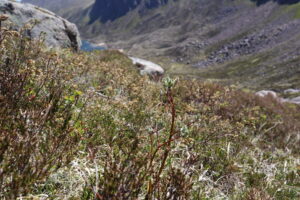
On a beautiful morning in early June, an assembly gathers in Cairngorm Mountain ski car park. Names are checked off a list as anticipation builds and the scent of sun lotion hovers in the bright air. We wait with large empty rucksacks, soon to be filled with precious cargo.
This is the third Willow Walk organised by Cairngorms Connect. An annual event, held at the start of summer, teams of volunteers walk willow cuttings and seedlings into the remote Loch A’an basin. Special permissions have been obtained and Mountain Leaders are on hand to guide us safely into this rugged landscape, the natural home for these trees.
Like a stately pilgrimage, the convivial company walks up to the top of the ski runs where we meet the young trees. 4000 seedlings and cuttings are carefully packaged up for the journey over the mountain. The buckets and bags contain three species of willow. There is the fluffy leaved downy willow (salix lapponum), the shiny green whortle-leaved willow (salix myrsinites) and cuttings of eared willow (salix aurita). We cluster in to take packs and bundles, filling up our rucksacks with the weight of new life.
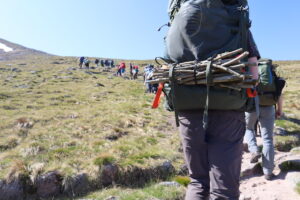
The willows belong to a particular type of woodland that is currently missing from most British mountains. It is the montane scrub – a layer of woodland that exists above the pine forests. As the environment becomes more extreme the taller trees give out to smaller shrubs and bushes, which provide precious food and shelter for insects, birds and animals. Yet there is so little of this habitat left on these shores that ecologists must travel to Norway to learn what montane scrub is. They report back in wonder, describing a colourful band of rich dwarf woodland, bursting with life.
In 2018, an ecologist surveyed the Loch A’an basin to locate the remnants of the montane woodland. On her survey of the three-mile long basin, she found 39 willows. These individuals are the remnants of an ancient habitat that once filled this special place, but had been decimated by over grazing and historical land use. With just 39 plants left, the willow population – once genetically diverse – had become too fragmented and distant to breed. The Loch A’an willows were on the verge of extinction.
Cuttings were taken and seedlings were propagated and the result is something remarkably hopeful. The last two Willow Walks were great successes. Of the 4500 willows previously returned to the basin by volunteer teams, ecologists report a high survival rate. Good deer management is crucial; while there is some browsing from hares, it is manageable and the resilient trees can cope. This year, the new willows have produced catkins and will start regenerating. The seeds of hope are returning to this landscape.
As I clamber up the mountain carrying my share of new woodland, I talk to David, who runs the tree nursery at Abernethy, where these young willows were grown and cared for. I ask how it feels to see his babies released into the wild. He is happy. A pragmatic arborist, he tells me there will be less weeding and watering to do.
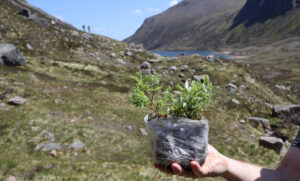
Stopping at Cairn 1141 on the plateau, Steve from Cairngorms Connect lets us catch our breath and take in the panorama. An eagle’s eye-view of the 200-year landscape restoration project unfolds. We look back down to the dark expanse of Abernethy Forest where the tree nursery hides among the pines. Above the forest, he points out mountain peatland that is also being restored and further up the strath he gestures to wetland habitats at RSPB Scotland Insh Marshes. These varied ecosystems are all part of the story that we are writing on this memorable day.
Ecologically speaking, the UK is in a bad way. David Attenborough’s recent Wild Isles documentary is yet another wake up call, alerting us to the dire state of nature on our doorstep. The reports are alarming. Since the Industrial Revolution, we have lost nearly half our biodiversity. Globally, we are in the bottom 10%. Eco-anxiety is a term for the fear that many feel for the future of our planet.
Today, snow still shines in patches on the high mountain but the blazing sun reminds us of challenges ahead. The effects of climate change are becoming apparent. We have no glaciers to lose here but with rising temperatures, plants, insects and animals are migrating uphill – and the hill is finite.
Falling into step with Ewan, a warden for RSPB, who surveys ptarmigan, plover, snow bunting and other creatures on the Cairngorms, he tells me that climate change means we will lose many specialist mountain species. They will retreat and then disappear.
*
We continue around the plateau, skirting boulder fields and passing over a snow patch where the reindeer herd takes refuge from the heat.
The issue is not just trees – it’s people too. We need a new nature culture. A way of reintegrating humans with nature that allows all species to flourish. Walking in the sunshine with this crew bearing the great load of willow on our backs, that culture feels less like a distant prospect. I talk with rangers, ecologists, artists and officers working on every part of this varied landscape. The collective, connective energy of the project is clear.
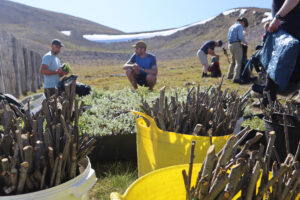
As well as the professionals and older veterans, the future guardians are also present. A group of four Junior Rangers aged 14-16 are on day release from schools across the Cairngorms National Park. Each month they meet to do conservation work across the Park. The girls excitedly tell me about their summer trip to the Junior Ranger Camp at Frederikshavn in Denmark. There they will meet other young people from National Parks across Europe and find themselves part of a network that spans the continent, connecting people to nature and to each other, ensuring the future of our wild lands. After all, this is their inheritance, their future.
To handle the challenges ahead, we need connection and action. There is much to be done, but Thijs, an ecologist working with curlew and waders on Insh Marshes is hopeful:
“This area is really cool – it’s one of the only places in the UK where it is changing for the better. You can see the change happening before you with more trees appearing on the mountain.”
Despite the heavy packs, I feel buoyed. I am not alone. Surrounded by this smiling company, the future shines bright and green.
*
Passing Coire Domhain, we begin the steep drop into Loch A’an basin. Water pours down granite slabs and cliffs appear. We hunt for signs of life and yes – there – tiny coloured specks betray climbers working epic lines on Shelterstone and Hell’s Lum. This is a magical place.
Down, down, down we descend until finally we reach the drop-off point and take the weight off our backs. The young trees are dunked in the sparkling river, giving them a good bath before they are stashed in shade between boulders. The planter eyes them all over. He will return with a small team and over four days, they will plant all 4000 specimens into designated areas. The new trees will join the old, bolstering the growing community of willows in the basin, connecting up the fragmented stands.
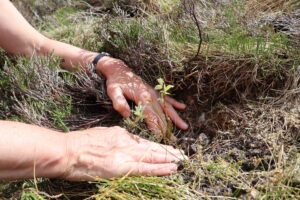
Our work now done, we continue down to the beach and swimmers strip off, striking out into the freezing blue eye of Loch A’an for a brilliant mass dip. We call and chatter in the water, like seals and birds, taking in our surroundings.
If trees can talk, then I wonder what conversations will begin in this hallowed place? What communities will form around the willows – how many lichens, mosses, plants, flowers, insects, birds and animals will find new homes around these trees? How will things change below the surface – between the roots and rocks and within the soils?
Another question turns in my mind. As the work team dries off in the sunshine, lounging in the warm sands, I turn to Ewan, who has a deep understanding of this place.
“How will Loch A’an basin look in a hundred years’ time?”
His answer is clear.
“In a hundred years’ time this place will be full of berries. The thrushes will come in to feast in autumn when this place is bursting with colour and life and sound. Beasts and flowers, insects and moths and pines trees – there will be montane scrub growing right up to crags – and they will be full of plants too.”
I love the vision but –
“We won’t see it. In a hundred years’ time, I’ll be 134.”
Ewan will be 132 and Kirsty 125. We share the same problem. None of us will live to see this change happen. Ewan offers another perspective.
“In Braiding Sweetgrass, Robin Wall Kimmerer talks of sitting on a hot day in the shade of a tree planted in her garden by someone who had thought the shade would be useful – so they planted the tree – but knowing they would never live to feel its benefit in their own lifetime. I love being part of something that I’m not going to see come into fruition.”
Now there’s the long view – a way of seeing that goes far beyond the individual to benefits that will be felt by many in distant years to come.
As we wind our way back out of the mountain, it strikes me that many remarkable things will come from this day. Ecologically, we must make great changes to ensure a biodiverse future for all. On this day, when 60 people carried 4000 willows into the Loch A’an basin, it appears we are already on that journey, walking the changes we need into being.
***
Cairngorms Connect is a partnership of neighbouring land managers working towards a 200-year vision to enhance habitat, species, and ecological process across a vast area within the Cairngorms National Park.